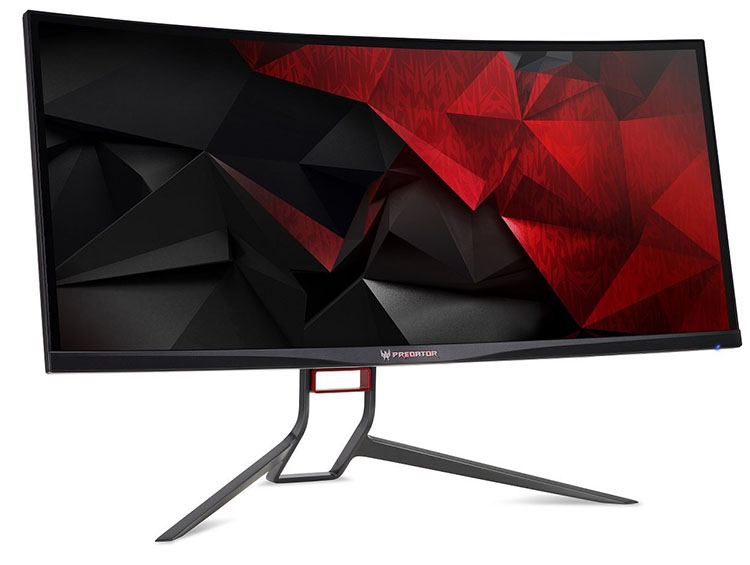Tom's Hardware Verdict
There is little to dislike about the Acer Predator X34P. It has G-Sync and 120Hz support wrapped up in a 1900R-curved IPS screen with accurate color and good contrast, made even better by a unique approach to gamma that works extremely well. It’s better-looking than its predecessor, and speedier too.
Pros
- +
120Hz refresh & G-Sync support
- +
Accurate gamma and color after calibration
- +
OSD joystick
- +
Nice Styling & build quality
Cons
- -
Lacks the contrast of a VA panel
- -
No ULMB (if that matters to you)
Why you can trust Tom's Hardware
Features & Specifications
Acer has long-represented a quiet competence in the gaming monitor arena. Rather than flashy styling and mega-refresh rates, the company chooses to deliver reliable performance in a simpler package that's often priced lower than the competition. Curved monitors come in many different radii, and only the end-user can decide which is best for them. For those seeking a little less curve in their curved display, there’s the Predator X34 with a 3800R radius. We first reviewed this excellent screen two years ago, and today we’re looking at an updated model, the X34P, which currently sells for about $1,100. It has the same 3440x1440 resolution and G-Sync as before, but the refresh rate is now a reliable 120Hz with overclock, and the panel wraps around more with a 1900R curve radius. It's also still one of the few Nvidia-focused monitors to forgo ultra-low motion blur (ULMB) support.
Yes, you read correctly above, the Predator X34P does not have ULMB. Is that an issue? We don’t think so. While we have no hard data on how many gamers actually use the feature, it’s never mentioned in reader comments. And since it inevitably reduces both peak light output and contrast, we can’t see it’s benefit over G-Sync. Until it works at higher refresh rates (a few monitors can run it at 144Hz but most are limited to 120), we’ll always choose adaptive sync to keep the action smooth and artifact-free.
Acer’s new panel part brings a more-reliable 120Hz refresh rate to the table. We’ve heard reports of X34s that could not exceed their native 75Hz without flickering. The X34P runs at 100Hz out of the box and 120Hz with the overclock setting engaged. Our sample ran for a week of intense testing and gameplay without a hiccup at its maximum speed. We call that a problem solved.
The curve is now more pronounced at 1900R versus the X34’s 3800R. It’s an obvious change and one that increases the wraparound effect and sense of immersion. If you check out our review of the original Predator X34, you can easily compare the top-down photos to see the difference.
At 34 inches, the Predator X34P is on the small end of the curved monitor universe. We’re seeing an increase in size with 35” and 38” screens becoming more common. And Samsung’s monstrous CHG90 49-incher just arrived at our lab for testing. It seems that panels just keep getting bigger. Let’s dive into the ample carton and see what’s new.
Specifications
| Brand & Model | Acer Predator X34P |
| Panel Type & Backlight | IPS / W-LED, edge array |
| Screen Size & Aspect Ratio | 34" / 21:9Curve Radius - 1900mm |
| Max Resolution & Refresh | 3440x1440 @ 100Hz120Hz w/overclockDensity - 110ppi |
| Native Color Depth & Gamut | 10-bit (8-bit+FRC) / sRGB |
| Response Time (GTG) | 4ms |
| Brightness | 300 nits |
| Contrast | 1000:1 |
| Speakers | 2 x 7w |
| Video Inputs | 1 x DisplayPort 1.21 x HDMI 1.4 |
| Audio | 3.5mm headphone output |
| USB | v3.0 - 1 x up, 4 x down |
| Power Consumption | 46w, brightness @ 200 nits |
| Panel DimensionsWxHxD w/base | 32.1 x 17.2-22.1 x 12"815 x 437-561 x 305mm |
| Panel Thickness | 4.1" / 104mm |
| Bezel Width | Top/sides - .4" / 11mmBottom - .8" / 21mm |
| Weight | 21.4lbs / 9.7kg |
Product 360
The X34P ships fully-assembled; you simply pull it out of the box by its stout handle. Every computer monitor, regardless of type should have a handle at the top of the stand. So let it be written. So let it be done.
The cable bundle consists of a medium-sized power supply brick, HDMI, DisplayPort, and USB 3.0 cables. A small cover snaps over the input panel along with a stand clip to help keep wires tidy. A printed quick-start guide is in the box, along with the warranty card. A user manual can be downloaded from Acer’s website. For monitor arm users, an adapter bracket with 100mm VESA holes is included that bolts on with supplied hardware.
Get Tom's Hardware's best news and in-depth reviews, straight to your inbox.
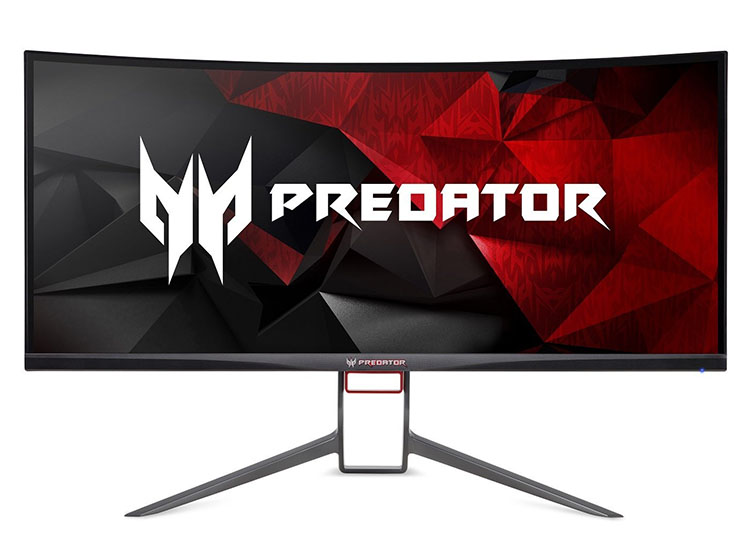
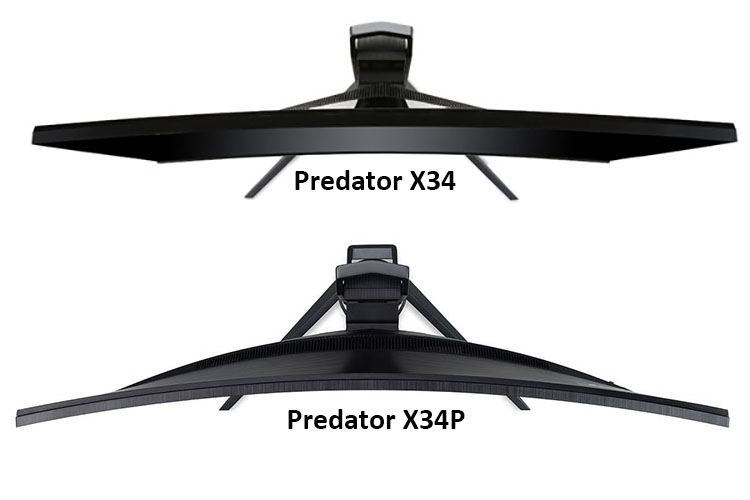
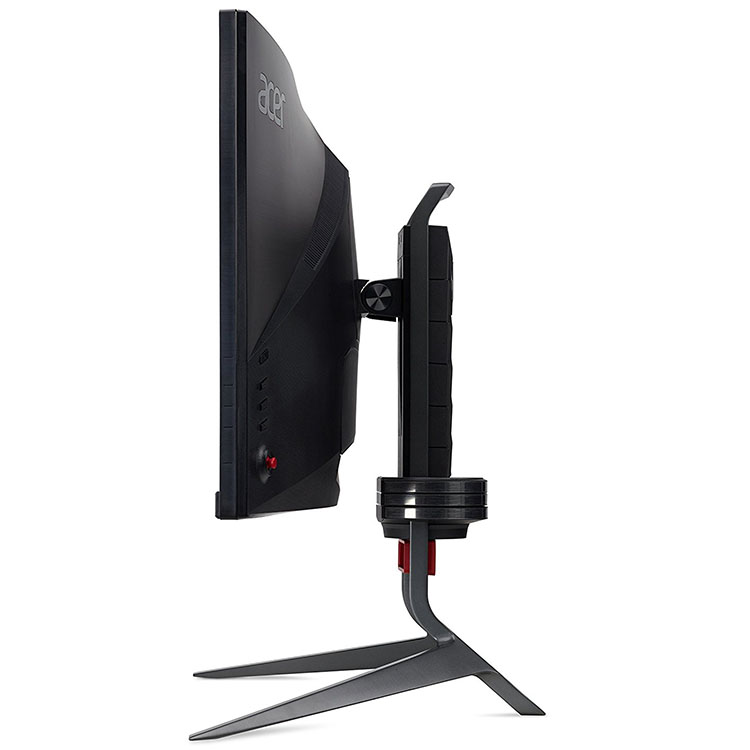
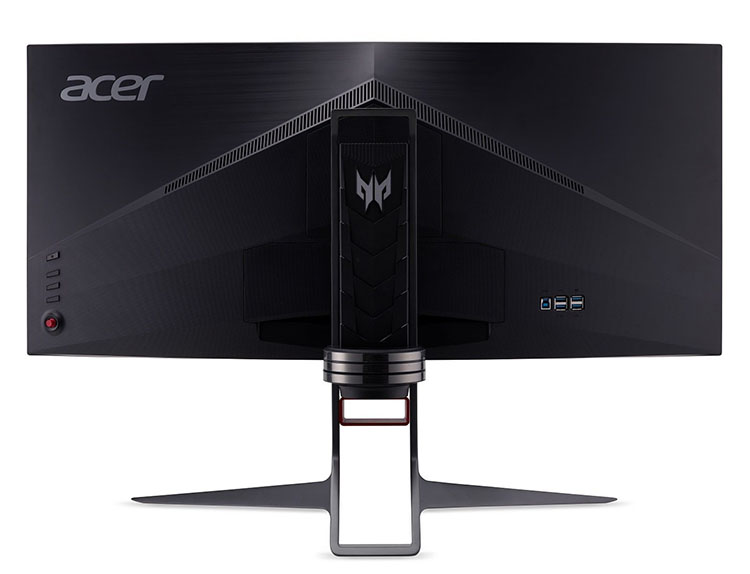
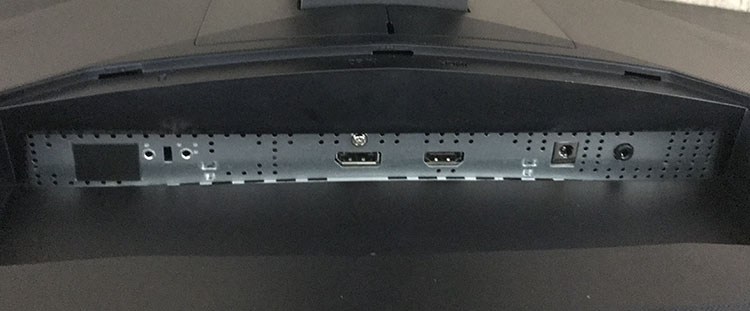
The second photo above clearly shows the difference between the Predator X34P and its predecessor. The curve is quite a bit more obvious and we think it’s an improvement. Even the most severely-curved screens manage to display their images without distortion, so that’s not a worry. For us, the more it wraps around, the better. And given the relatively small 34” screen, every little bit helps. The front layer is flush-mounted, so the bezel effectively disappears when the monitor’s off. A thin 11mm frame can be seen when an image is on the screen; zero-frame just isn’t quite a reality yet, but we're getting there. The anti-glare factor is high here, but we saw no grain or sparkle effects, just a clear picture.
The stand is updated as well, with a new swivel feature courtesy of a cool-looking bearing that is prominently displayed. It includes small tick marks so you can see when the panel and base are perfectly aligned. The mechanism moves with firm precision and stays where you put it. The same is true of the nearly 5” height adjustment, which operates with the same solid feel. Swivel is 30° in each direction, with 35° back tilt and 5° forward. The stand looks a bit slight, but is actually solid as a rock. It’s all-metal, with a generous 12” depth. Your Predator X34P isn’t going anywhere, unless someone picks it up by the handle on top.
The styling hasn’t changed much, but the chassis’ plastic cover and trim is now all-matte, rather than the gloss-black used before. That will help squash annoying reflections in dark rooms, and it fits in nicely with the stand’s black anodized finish. The same angles are still there, with a good amount of ventilation provided by the strip across the back. Also hiding in there are a pair of excellent speakers driven by seven watts of amplification apiece. They play nice and loud without distortion and even provide a fair amount of bass at times; the speakers are definitely a cut above the norm.
From the side you can see an OSD joystick and four control keys. The top button is a power toggle and is separated from the rest to prevent accidental shut-downs. The remaining three are programmable in the OSD. The joystick makes dialing in the Predator X34P very easy, and is also an upgrade from the X34.
Inputs face downwards and include just one each of HDMI and DisplayPort. Also here is a 3.5mm audio jack for headphones or powered speakers. The USB ports are version 3.0 and face back, which is very convenient. You get one upstream port and four downstream ports.
MORE: Best Gaming Monitors
MORE: How We Test Monitors
MORE: All Monitor Content

Christian Eberle is a Contributing Editor for Tom's Hardware US. He's a veteran reviewer of A/V equipment, specializing in monitors. Christian began his obsession with tech when he built his first PC in 1991, a 286 running DOS 3.0 at a blazing 12MHz. In 2006, he undertook training from the Imaging Science Foundation in video calibration and testing and thus started a passion for precise imaging that persists to this day. He is also a professional musician with a degree from the New England Conservatory as a classical bassoonist which he used to good effect as a performer with the West Point Army Band from 1987 to 2013. He enjoys watching movies and listening to high-end audio in his custom-built home theater and can be seen riding trails near his home on a race-ready ICE VTX recumbent trike. Christian enjoys the endless summer in Florida where he lives with his wife and Chihuahua and plays with orchestras around the state.
-
feelinfroggy777 If I did not already have the x34, I would get this monitor in a heartbeat. But for now, I guess I will just wait till the 200hz panel is released.Reply -
Ninjawithagun Acer copied Dell Alienware's AW3418DW, but failed to match the much better quality of the AW unit. And the Acer has an external power brick (similar to that of a laptop). NO THANK YOU! I prefer the integrated power unit within the AW unit. Also, the price for the Acer X34P is too high. I bought both of my AW3418DW units for $930/each with a 4-year free replacement warranties ;-)Reply -
adambomb13 DO NOT BUY ACER MONITORS at least the one with GSync capable, I bought a xb321hk for $1000.00 and got the famous artifacting and screen blanking issue.Reply
Below link for Acer's community forum regarding this issue
https://community.acer.com/en/discussion/441879/xb321hk-weird-artifact/p1
I have reached the END of Acers customer service line, They only offered me $400 refund LOL. After 5 returns, 3 different xb321hk monitors, I have worked with Corporate Customer service and "Elite" technical support and wasted 3-4 months for $400.00 refund.... Unbelievable. I will continue to post my personal experience on websites and I'll update my Youtube video warning people NOT to buy ACER?, -
adambomb13 DO NOT BUY ACER MONITORS at least the one with GSync capable, I bought a xb321hk for $1000.00 and got the famous artifacting and screen blanking issue.Reply
Below link for Acer's community forum regarding this issue
https://community.acer.com/en/discussion/441879/xb321hk-weird-artifact/p1
I have reached the END of Acers customer service line, They only offered me $400 refund LOL. After 5 returns, 3 different xb321hk monitors, I have worked with Corporate Customer service and "Elite" technical support and wasted 3-4 months for $400.00 refund.... Unbelievable. I will continue to post my personal experience on websites and I'll update my Youtube video warning people NOT to buy ACER?, -
Ninjawithagun Reply21070004 said:DO NOT BUY ACER MONITORS at least the one with GSync capable, I bought a xb321hk for $1000.00 and got the famous artifacting and screen blanking issue.
Below link for Acer's community forum regarding this issue
https://community.acer.com/en/discussion/441879/xb321hk-weird-artifact/p1
I have reached the END of Acers customer service line, They only offered me $400 refund LOL. After 5 returns, 3 different xb321hk monitors, I have worked with Corporate Customer service and "Elite" technical support and wasted 3-4 months for $400.00 refund.... Unbelievable. I will continue to post my personal experience on websites and I'll update my Youtube video warning people NOT to buy ACER?,
The flicker issue is caused by cheap DisplayPort cables being used by consumers. I had a similar issue with my Acer XB321HK unit. I replaced the stock cable with a high quality DP 1.4 certified cable and the issue disappeared. Yes, I know the XB31HK comes with only a DP 1.2 port, but the high quality DP 1.4 cable has extra shielding, which apparently eliminates the flicker issue due to signal degradation from the graphics card to the monitor. -
Kahless01 Reply21069959 said:Acer copied Dell Alienware's AW3418DW, but failed to match the much better quality of the AW unit. And the Acer has an external power brick (similar to that of a laptop). NO THANK YOU! I prefer the integrated power unit within the AW unit. Also, the price for the Acer X34P is too high. I bought both of my AW3418DW units for $930/each with a 4-year free replacement warranties ;-)
they didnt copy anyone. only one company makes the panels so everyone takes them and designs products from them. you wont see much more than packaging differences. and what you got the monitors for and their msrp arent the same thing. i can get the acer for $830. your aw with the build in power supply is also 4.5lbs heavier. i move my monitor around alot. that makes a difference.
and other dude. why the hell are you playing diablo 3 on an expensive 4k monitor? seems like wasted money. the problems youre describing are as much an nvidia problem as an acer problem. all you need to do is change your search from acer artifacting to gsync artifacting and youll see its pretty widespread. i can guarantee you that your monitor isnt being tested like you think it is. its being put on a big rack not being watched. its checked on to see if its failed after a few hours and if it hasnt its shipped on. they sure as hell arent going to give techs gaming computers to dink around on your one monitor playing a 6 year old hack n slash game. -
AcesB Many gamers buy G-Sync monitors to have ULMB (me included). Sync is not a real issue in high refresh games powered by GXT 1070/1080 and higher, as they run steady and stable at 100Hz/120Hz, a typical fixed refresh rate with ULMB.Reply
If you don't know, G-Sync and ULMB can not work at same time. If you game already runs fine in +100/120 fps there is no reason to enable GSync. BUT the crystal clear images produced by ULMB are out of this word. ( At least in my Dell S2716 DGR) -
rhysiam Am I the only one who's pretty disappointed at the lack of progress in gaming monitors over the last few years? I mean, the original X34 released at $1300. So nearly 3 years later we get a very similar product with a few improvements at 15% less. It's a little better and a little cheaper, sure, but it's really just an iterative upgrade.Reply
If you compare that to TVs, take a look at what you can get for your money at just about any price bracket today vs 3 years ago and the difference is massive. We just don't seem to be seeing the same level of progress in gaming monitors. Am I missing something?? -
adambomb13 KAHLESS01 I play other games too LOL, but anyways I'll never buy another Acer productReply
